Tesco PLC's Innovation: Future Capabilities and Strategies Report
VerifiedAdded on 2020/10/22
|18
|6326
|307
Report
AI Summary
This report provides a comprehensive analysis of innovation strategies for Tesco PLC, the largest retail store in the UK. It examines the future of the retail industry, highlighting the impact of competitors' innovations and the need for Tesco to adopt new technologies and strategies. The report is divided into three parts: the first part explores the future innovations of Tesco's competitors and their impact; the second part focuses on Tesco's innovation requirements, including artificial intelligence, robot assistance, and virtual lockers; and the third part discusses Tesco's future innovative capabilities, including factors affecting innovation and a roadmap for implementation. The report recommends that Tesco PLC implement innovative plans to develop future capabilities and continuously review implemented changes to maintain its market position.
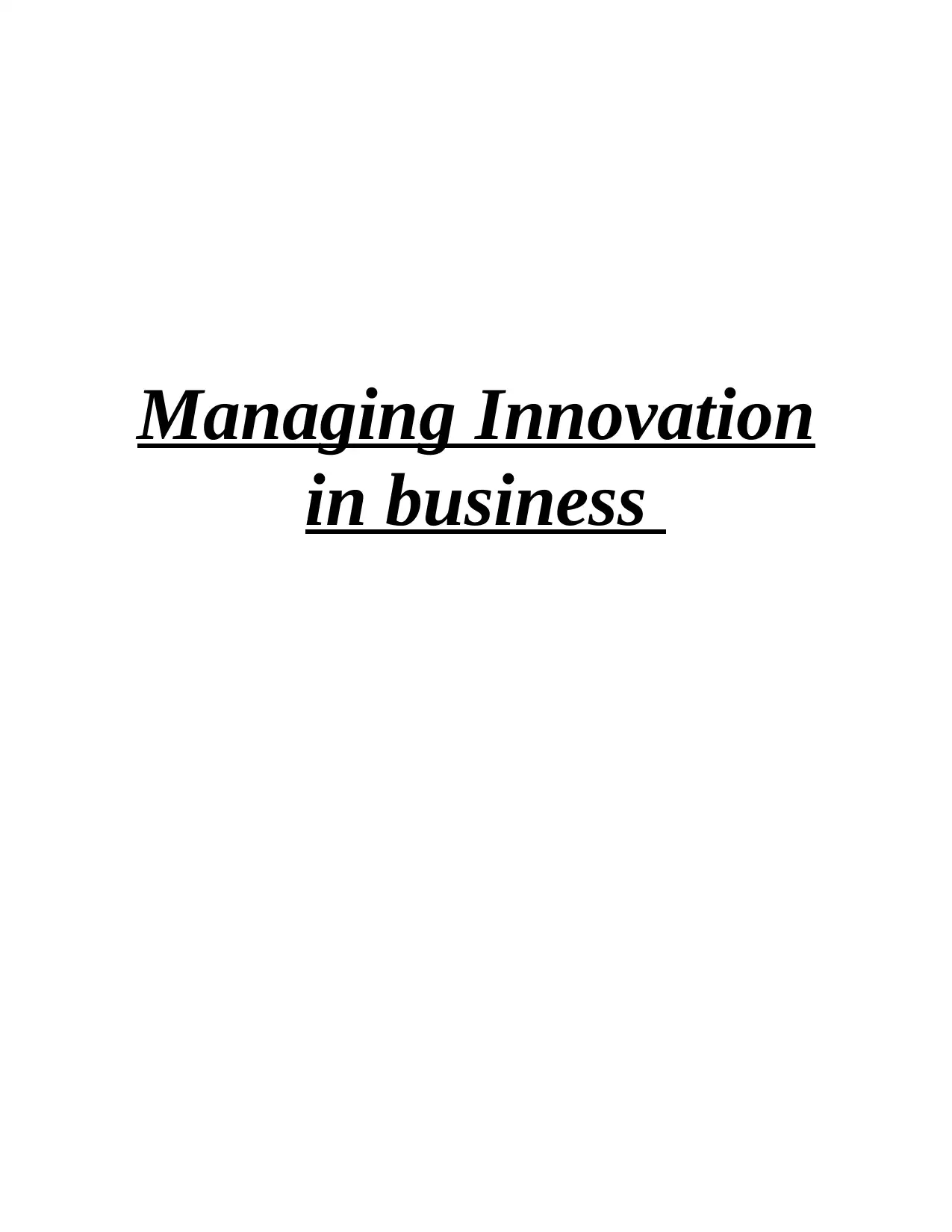
Managing Innovation
in business
in business
Paraphrase This Document
Need a fresh take? Get an instant paraphrase of this document with our AI Paraphraser
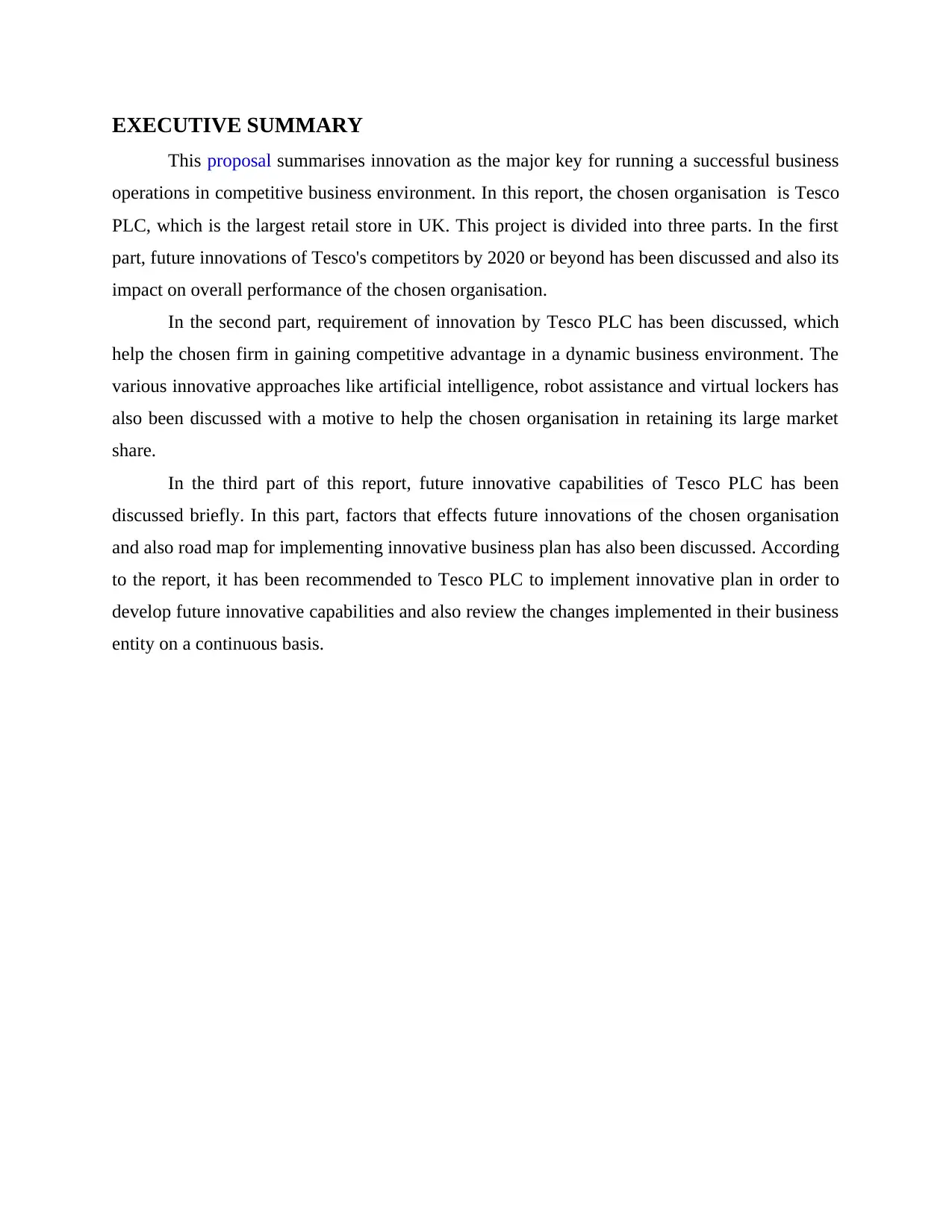
EXECUTIVE SUMMARY
This proposal summarises innovation as the major key for running a successful business
operations in competitive business environment. In this report, the chosen organisation is Tesco
PLC, which is the largest retail store in UK. This project is divided into three parts. In the first
part, future innovations of Tesco's competitors by 2020 or beyond has been discussed and also its
impact on overall performance of the chosen organisation.
In the second part, requirement of innovation by Tesco PLC has been discussed, which
help the chosen firm in gaining competitive advantage in a dynamic business environment. The
various innovative approaches like artificial intelligence, robot assistance and virtual lockers has
also been discussed with a motive to help the chosen organisation in retaining its large market
share.
In the third part of this report, future innovative capabilities of Tesco PLC has been
discussed briefly. In this part, factors that effects future innovations of the chosen organisation
and also road map for implementing innovative business plan has also been discussed. According
to the report, it has been recommended to Tesco PLC to implement innovative plan in order to
develop future innovative capabilities and also review the changes implemented in their business
entity on a continuous basis.
This proposal summarises innovation as the major key for running a successful business
operations in competitive business environment. In this report, the chosen organisation is Tesco
PLC, which is the largest retail store in UK. This project is divided into three parts. In the first
part, future innovations of Tesco's competitors by 2020 or beyond has been discussed and also its
impact on overall performance of the chosen organisation.
In the second part, requirement of innovation by Tesco PLC has been discussed, which
help the chosen firm in gaining competitive advantage in a dynamic business environment. The
various innovative approaches like artificial intelligence, robot assistance and virtual lockers has
also been discussed with a motive to help the chosen organisation in retaining its large market
share.
In the third part of this report, future innovative capabilities of Tesco PLC has been
discussed briefly. In this part, factors that effects future innovations of the chosen organisation
and also road map for implementing innovative business plan has also been discussed. According
to the report, it has been recommended to Tesco PLC to implement innovative plan in order to
develop future innovative capabilities and also review the changes implemented in their business
entity on a continuous basis.
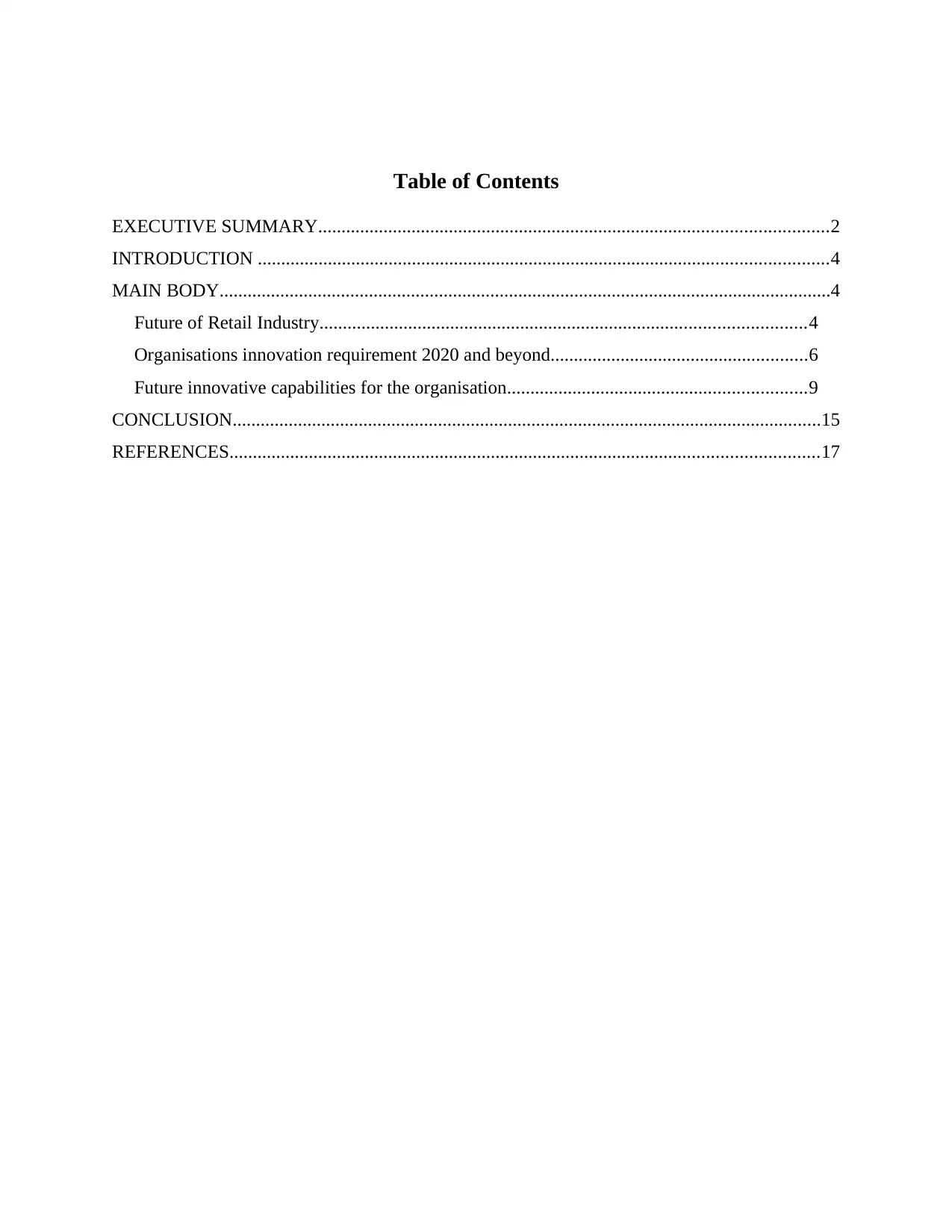
Table of Contents
EXECUTIVE SUMMARY.............................................................................................................2
INTRODUCTION ..........................................................................................................................4
MAIN BODY...................................................................................................................................4
Future of Retail Industry........................................................................................................4
Organisations innovation requirement 2020 and beyond.......................................................6
Future innovative capabilities for the organisation................................................................9
CONCLUSION..............................................................................................................................15
REFERENCES..............................................................................................................................17
EXECUTIVE SUMMARY.............................................................................................................2
INTRODUCTION ..........................................................................................................................4
MAIN BODY...................................................................................................................................4
Future of Retail Industry........................................................................................................4
Organisations innovation requirement 2020 and beyond.......................................................6
Future innovative capabilities for the organisation................................................................9
CONCLUSION..............................................................................................................................15
REFERENCES..............................................................................................................................17
⊘ This is a preview!⊘
Do you want full access?
Subscribe today to unlock all pages.

Trusted by 1+ million students worldwide
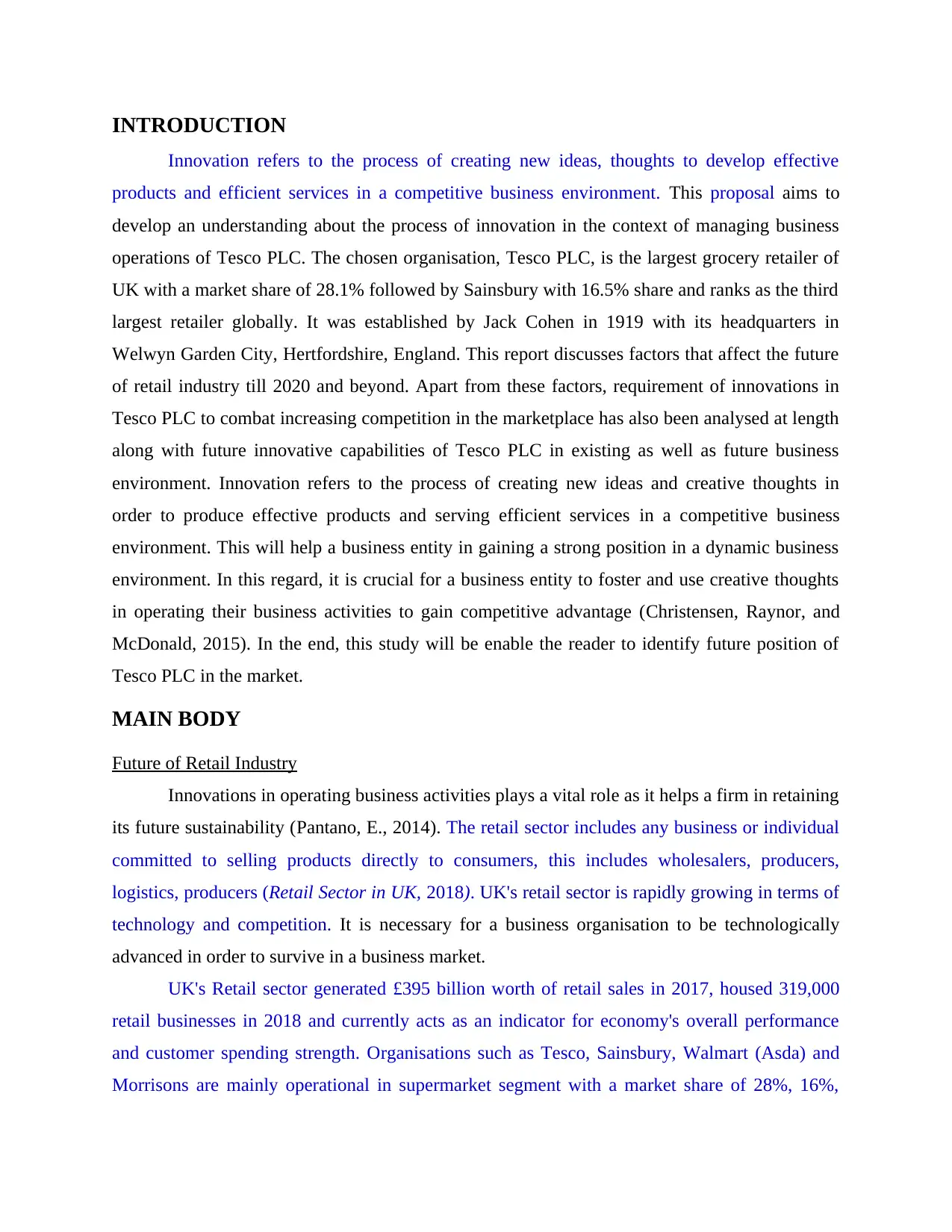
INTRODUCTION
Innovation refers to the process of creating new ideas, thoughts to develop effective
products and efficient services in a competitive business environment. This proposal aims to
develop an understanding about the process of innovation in the context of managing business
operations of Tesco PLC. The chosen organisation, Tesco PLC, is the largest grocery retailer of
UK with a market share of 28.1% followed by Sainsbury with 16.5% share and ranks as the third
largest retailer globally. It was established by Jack Cohen in 1919 with its headquarters in
Welwyn Garden City, Hertfordshire, England. This report discusses factors that affect the future
of retail industry till 2020 and beyond. Apart from these factors, requirement of innovations in
Tesco PLC to combat increasing competition in the marketplace has also been analysed at length
along with future innovative capabilities of Tesco PLC in existing as well as future business
environment. Innovation refers to the process of creating new ideas and creative thoughts in
order to produce effective products and serving efficient services in a competitive business
environment. This will help a business entity in gaining a strong position in a dynamic business
environment. In this regard, it is crucial for a business entity to foster and use creative thoughts
in operating their business activities to gain competitive advantage (Christensen, Raynor, and
McDonald, 2015). In the end, this study will be enable the reader to identify future position of
Tesco PLC in the market.
MAIN BODY
Future of Retail Industry
Innovations in operating business activities plays a vital role as it helps a firm in retaining
its future sustainability (Pantano, E., 2014). The retail sector includes any business or individual
committed to selling products directly to consumers, this includes wholesalers, producers,
logistics, producers (Retail Sector in UK, 2018). UK's retail sector is rapidly growing in terms of
technology and competition. It is necessary for a business organisation to be technologically
advanced in order to survive in a business market.
UK's Retail sector generated £395 billion worth of retail sales in 2017, housed 319,000
retail businesses in 2018 and currently acts as an indicator for economy's overall performance
and customer spending strength. Organisations such as Tesco, Sainsbury, Walmart (Asda) and
Morrisons are mainly operational in supermarket segment with a market share of 28%, 16%,
Innovation refers to the process of creating new ideas, thoughts to develop effective
products and efficient services in a competitive business environment. This proposal aims to
develop an understanding about the process of innovation in the context of managing business
operations of Tesco PLC. The chosen organisation, Tesco PLC, is the largest grocery retailer of
UK with a market share of 28.1% followed by Sainsbury with 16.5% share and ranks as the third
largest retailer globally. It was established by Jack Cohen in 1919 with its headquarters in
Welwyn Garden City, Hertfordshire, England. This report discusses factors that affect the future
of retail industry till 2020 and beyond. Apart from these factors, requirement of innovations in
Tesco PLC to combat increasing competition in the marketplace has also been analysed at length
along with future innovative capabilities of Tesco PLC in existing as well as future business
environment. Innovation refers to the process of creating new ideas and creative thoughts in
order to produce effective products and serving efficient services in a competitive business
environment. This will help a business entity in gaining a strong position in a dynamic business
environment. In this regard, it is crucial for a business entity to foster and use creative thoughts
in operating their business activities to gain competitive advantage (Christensen, Raynor, and
McDonald, 2015). In the end, this study will be enable the reader to identify future position of
Tesco PLC in the market.
MAIN BODY
Future of Retail Industry
Innovations in operating business activities plays a vital role as it helps a firm in retaining
its future sustainability (Pantano, E., 2014). The retail sector includes any business or individual
committed to selling products directly to consumers, this includes wholesalers, producers,
logistics, producers (Retail Sector in UK, 2018). UK's retail sector is rapidly growing in terms of
technology and competition. It is necessary for a business organisation to be technologically
advanced in order to survive in a business market.
UK's Retail sector generated £395 billion worth of retail sales in 2017, housed 319,000
retail businesses in 2018 and currently acts as an indicator for economy's overall performance
and customer spending strength. Organisations such as Tesco, Sainsbury, Walmart (Asda) and
Morrisons are mainly operational in supermarket segment with a market share of 28%, 16%,
Paraphrase This Document
Need a fresh take? Get an instant paraphrase of this document with our AI Paraphraser
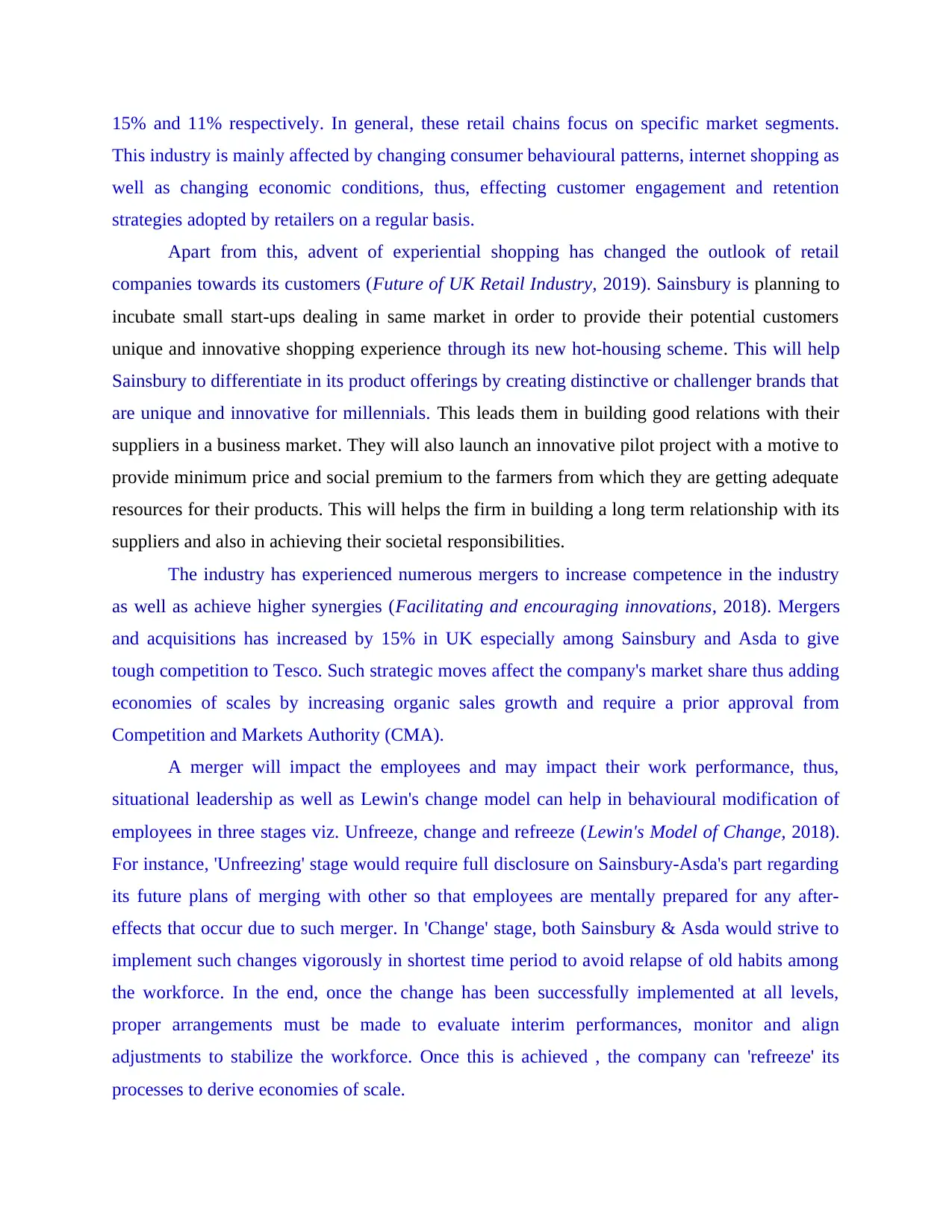
15% and 11% respectively. In general, these retail chains focus on specific market segments.
This industry is mainly affected by changing consumer behavioural patterns, internet shopping as
well as changing economic conditions, thus, effecting customer engagement and retention
strategies adopted by retailers on a regular basis.
Apart from this, advent of experiential shopping has changed the outlook of retail
companies towards its customers (Future of UK Retail Industry, 2019). Sainsbury is planning to
incubate small start-ups dealing in same market in order to provide their potential customers
unique and innovative shopping experience through its new hot-housing scheme. This will help
Sainsbury to differentiate in its product offerings by creating distinctive or challenger brands that
are unique and innovative for millennials. This leads them in building good relations with their
suppliers in a business market. They will also launch an innovative pilot project with a motive to
provide minimum price and social premium to the farmers from which they are getting adequate
resources for their products. This will helps the firm in building a long term relationship with its
suppliers and also in achieving their societal responsibilities.
The industry has experienced numerous mergers to increase competence in the industry
as well as achieve higher synergies (Facilitating and encouraging innovations, 2018). Mergers
and acquisitions has increased by 15% in UK especially among Sainsbury and Asda to give
tough competition to Tesco. Such strategic moves affect the company's market share thus adding
economies of scales by increasing organic sales growth and require a prior approval from
Competition and Markets Authority (CMA).
A merger will impact the employees and may impact their work performance, thus,
situational leadership as well as Lewin's change model can help in behavioural modification of
employees in three stages viz. Unfreeze, change and refreeze (Lewin's Model of Change, 2018).
For instance, 'Unfreezing' stage would require full disclosure on Sainsbury-Asda's part regarding
its future plans of merging with other so that employees are mentally prepared for any after-
effects that occur due to such merger. In 'Change' stage, both Sainsbury & Asda would strive to
implement such changes vigorously in shortest time period to avoid relapse of old habits among
the workforce. In the end, once the change has been successfully implemented at all levels,
proper arrangements must be made to evaluate interim performances, monitor and align
adjustments to stabilize the workforce. Once this is achieved , the company can 'refreeze' its
processes to derive economies of scale.
This industry is mainly affected by changing consumer behavioural patterns, internet shopping as
well as changing economic conditions, thus, effecting customer engagement and retention
strategies adopted by retailers on a regular basis.
Apart from this, advent of experiential shopping has changed the outlook of retail
companies towards its customers (Future of UK Retail Industry, 2019). Sainsbury is planning to
incubate small start-ups dealing in same market in order to provide their potential customers
unique and innovative shopping experience through its new hot-housing scheme. This will help
Sainsbury to differentiate in its product offerings by creating distinctive or challenger brands that
are unique and innovative for millennials. This leads them in building good relations with their
suppliers in a business market. They will also launch an innovative pilot project with a motive to
provide minimum price and social premium to the farmers from which they are getting adequate
resources for their products. This will helps the firm in building a long term relationship with its
suppliers and also in achieving their societal responsibilities.
The industry has experienced numerous mergers to increase competence in the industry
as well as achieve higher synergies (Facilitating and encouraging innovations, 2018). Mergers
and acquisitions has increased by 15% in UK especially among Sainsbury and Asda to give
tough competition to Tesco. Such strategic moves affect the company's market share thus adding
economies of scales by increasing organic sales growth and require a prior approval from
Competition and Markets Authority (CMA).
A merger will impact the employees and may impact their work performance, thus,
situational leadership as well as Lewin's change model can help in behavioural modification of
employees in three stages viz. Unfreeze, change and refreeze (Lewin's Model of Change, 2018).
For instance, 'Unfreezing' stage would require full disclosure on Sainsbury-Asda's part regarding
its future plans of merging with other so that employees are mentally prepared for any after-
effects that occur due to such merger. In 'Change' stage, both Sainsbury & Asda would strive to
implement such changes vigorously in shortest time period to avoid relapse of old habits among
the workforce. In the end, once the change has been successfully implemented at all levels,
proper arrangements must be made to evaluate interim performances, monitor and align
adjustments to stabilize the workforce. Once this is achieved , the company can 'refreeze' its
processes to derive economies of scale.
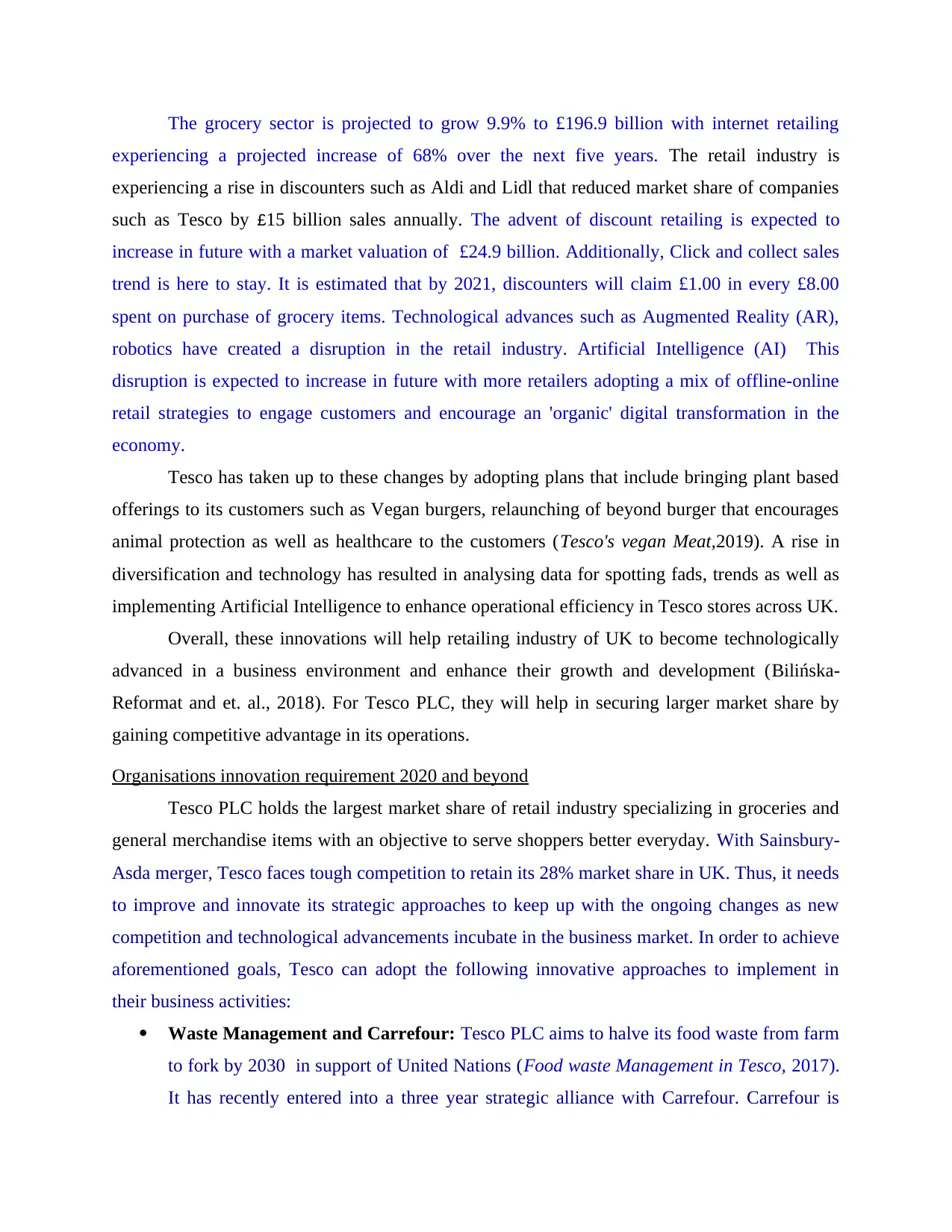
The grocery sector is projected to grow 9.9% to £196.9 billion with internet retailing
experiencing a projected increase of 68% over the next five years. The retail industry is
experiencing a rise in discounters such as Aldi and Lidl that reduced market share of companies
such as Tesco by £15 billion sales annually. The advent of discount retailing is expected to
increase in future with a market valuation of £24.9 billion. Additionally, Click and collect sales
trend is here to stay. It is estimated that by 2021, discounters will claim £1.00 in every £8.00
spent on purchase of grocery items. Technological advances such as Augmented Reality (AR),
robotics have created a disruption in the retail industry. Artificial Intelligence (AI) This
disruption is expected to increase in future with more retailers adopting a mix of offline-online
retail strategies to engage customers and encourage an 'organic' digital transformation in the
economy.
Tesco has taken up to these changes by adopting plans that include bringing plant based
offerings to its customers such as Vegan burgers, relaunching of beyond burger that encourages
animal protection as well as healthcare to the customers (Tesco's vegan Meat,2019). A rise in
diversification and technology has resulted in analysing data for spotting fads, trends as well as
implementing Artificial Intelligence to enhance operational efficiency in Tesco stores across UK.
Overall, these innovations will help retailing industry of UK to become technologically
advanced in a business environment and enhance their growth and development (Bilińska-
Reformat and et. al., 2018). For Tesco PLC, they will help in securing larger market share by
gaining competitive advantage in its operations.
Organisations innovation requirement 2020 and beyond
Tesco PLC holds the largest market share of retail industry specializing in groceries and
general merchandise items with an objective to serve shoppers better everyday. With Sainsbury-
Asda merger, Tesco faces tough competition to retain its 28% market share in UK. Thus, it needs
to improve and innovate its strategic approaches to keep up with the ongoing changes as new
competition and technological advancements incubate in the business market. In order to achieve
aforementioned goals, Tesco can adopt the following innovative approaches to implement in
their business activities:
Waste Management and Carrefour: Tesco PLC aims to halve its food waste from farm
to fork by 2030 in support of United Nations (Food waste Management in Tesco, 2017).
It has recently entered into a three year strategic alliance with Carrefour. Carrefour is
experiencing a projected increase of 68% over the next five years. The retail industry is
experiencing a rise in discounters such as Aldi and Lidl that reduced market share of companies
such as Tesco by £15 billion sales annually. The advent of discount retailing is expected to
increase in future with a market valuation of £24.9 billion. Additionally, Click and collect sales
trend is here to stay. It is estimated that by 2021, discounters will claim £1.00 in every £8.00
spent on purchase of grocery items. Technological advances such as Augmented Reality (AR),
robotics have created a disruption in the retail industry. Artificial Intelligence (AI) This
disruption is expected to increase in future with more retailers adopting a mix of offline-online
retail strategies to engage customers and encourage an 'organic' digital transformation in the
economy.
Tesco has taken up to these changes by adopting plans that include bringing plant based
offerings to its customers such as Vegan burgers, relaunching of beyond burger that encourages
animal protection as well as healthcare to the customers (Tesco's vegan Meat,2019). A rise in
diversification and technology has resulted in analysing data for spotting fads, trends as well as
implementing Artificial Intelligence to enhance operational efficiency in Tesco stores across UK.
Overall, these innovations will help retailing industry of UK to become technologically
advanced in a business environment and enhance their growth and development (Bilińska-
Reformat and et. al., 2018). For Tesco PLC, they will help in securing larger market share by
gaining competitive advantage in its operations.
Organisations innovation requirement 2020 and beyond
Tesco PLC holds the largest market share of retail industry specializing in groceries and
general merchandise items with an objective to serve shoppers better everyday. With Sainsbury-
Asda merger, Tesco faces tough competition to retain its 28% market share in UK. Thus, it needs
to improve and innovate its strategic approaches to keep up with the ongoing changes as new
competition and technological advancements incubate in the business market. In order to achieve
aforementioned goals, Tesco can adopt the following innovative approaches to implement in
their business activities:
Waste Management and Carrefour: Tesco PLC aims to halve its food waste from farm
to fork by 2030 in support of United Nations (Food waste Management in Tesco, 2017).
It has recently entered into a three year strategic alliance with Carrefour. Carrefour is
⊘ This is a preview!⊘
Do you want full access?
Subscribe today to unlock all pages.

Trusted by 1+ million students worldwide
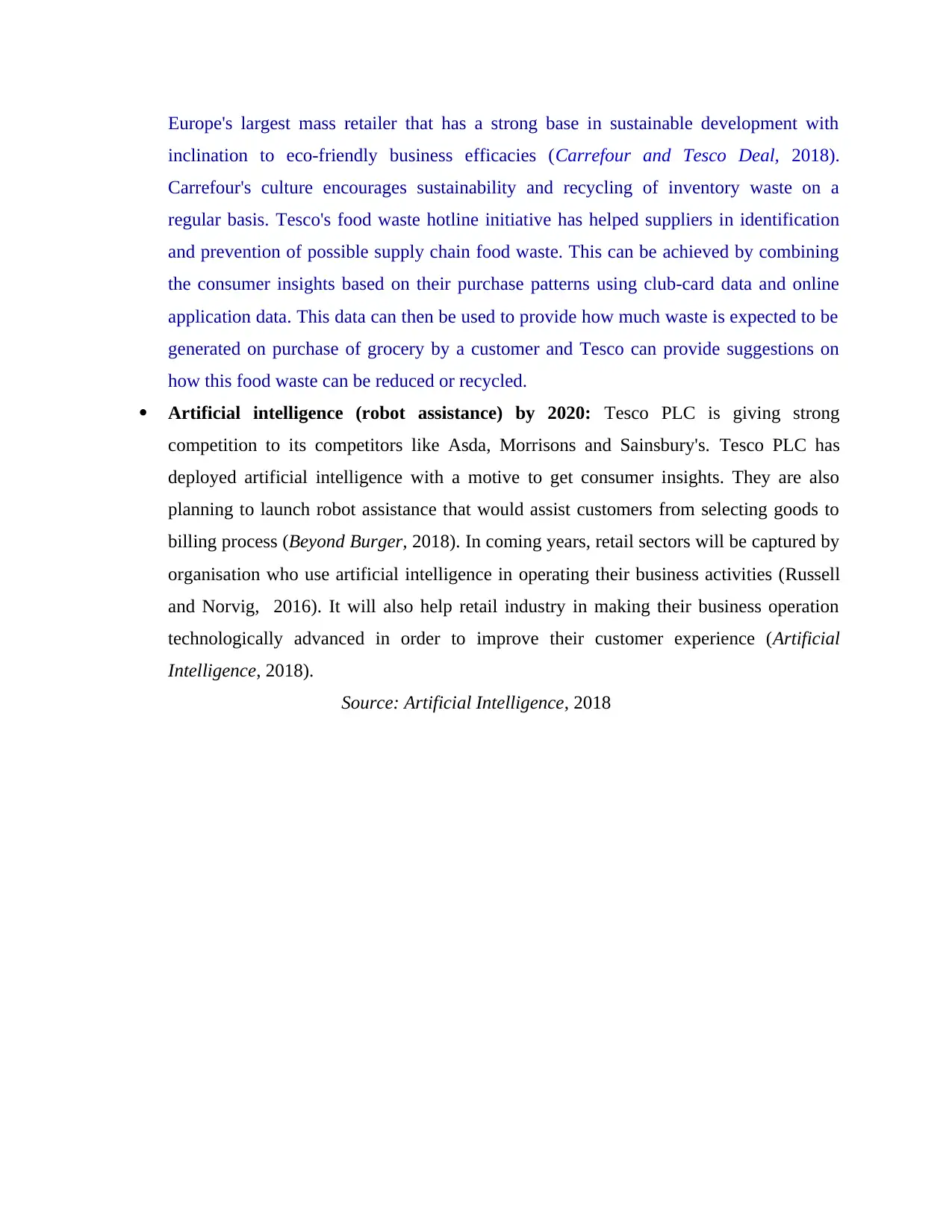
Europe's largest mass retailer that has a strong base in sustainable development with
inclination to eco-friendly business efficacies (Carrefour and Tesco Deal, 2018).
Carrefour's culture encourages sustainability and recycling of inventory waste on a
regular basis. Tesco's food waste hotline initiative has helped suppliers in identification
and prevention of possible supply chain food waste. This can be achieved by combining
the consumer insights based on their purchase patterns using club-card data and online
application data. This data can then be used to provide how much waste is expected to be
generated on purchase of grocery by a customer and Tesco can provide suggestions on
how this food waste can be reduced or recycled.
Artificial intelligence (robot assistance) by 2020: Tesco PLC is giving strong
competition to its competitors like Asda, Morrisons and Sainsbury's. Tesco PLC has
deployed artificial intelligence with a motive to get consumer insights. They are also
planning to launch robot assistance that would assist customers from selecting goods to
billing process (Beyond Burger, 2018). In coming years, retail sectors will be captured by
organisation who use artificial intelligence in operating their business activities (Russell
and Norvig, 2016). It will also help retail industry in making their business operation
technologically advanced in order to improve their customer experience (Artificial
Intelligence, 2018).
Source: Artificial Intelligence, 2018
inclination to eco-friendly business efficacies (Carrefour and Tesco Deal, 2018).
Carrefour's culture encourages sustainability and recycling of inventory waste on a
regular basis. Tesco's food waste hotline initiative has helped suppliers in identification
and prevention of possible supply chain food waste. This can be achieved by combining
the consumer insights based on their purchase patterns using club-card data and online
application data. This data can then be used to provide how much waste is expected to be
generated on purchase of grocery by a customer and Tesco can provide suggestions on
how this food waste can be reduced or recycled.
Artificial intelligence (robot assistance) by 2020: Tesco PLC is giving strong
competition to its competitors like Asda, Morrisons and Sainsbury's. Tesco PLC has
deployed artificial intelligence with a motive to get consumer insights. They are also
planning to launch robot assistance that would assist customers from selecting goods to
billing process (Beyond Burger, 2018). In coming years, retail sectors will be captured by
organisation who use artificial intelligence in operating their business activities (Russell
and Norvig, 2016). It will also help retail industry in making their business operation
technologically advanced in order to improve their customer experience (Artificial
Intelligence, 2018).
Source: Artificial Intelligence, 2018
Paraphrase This Document
Need a fresh take? Get an instant paraphrase of this document with our AI Paraphraser
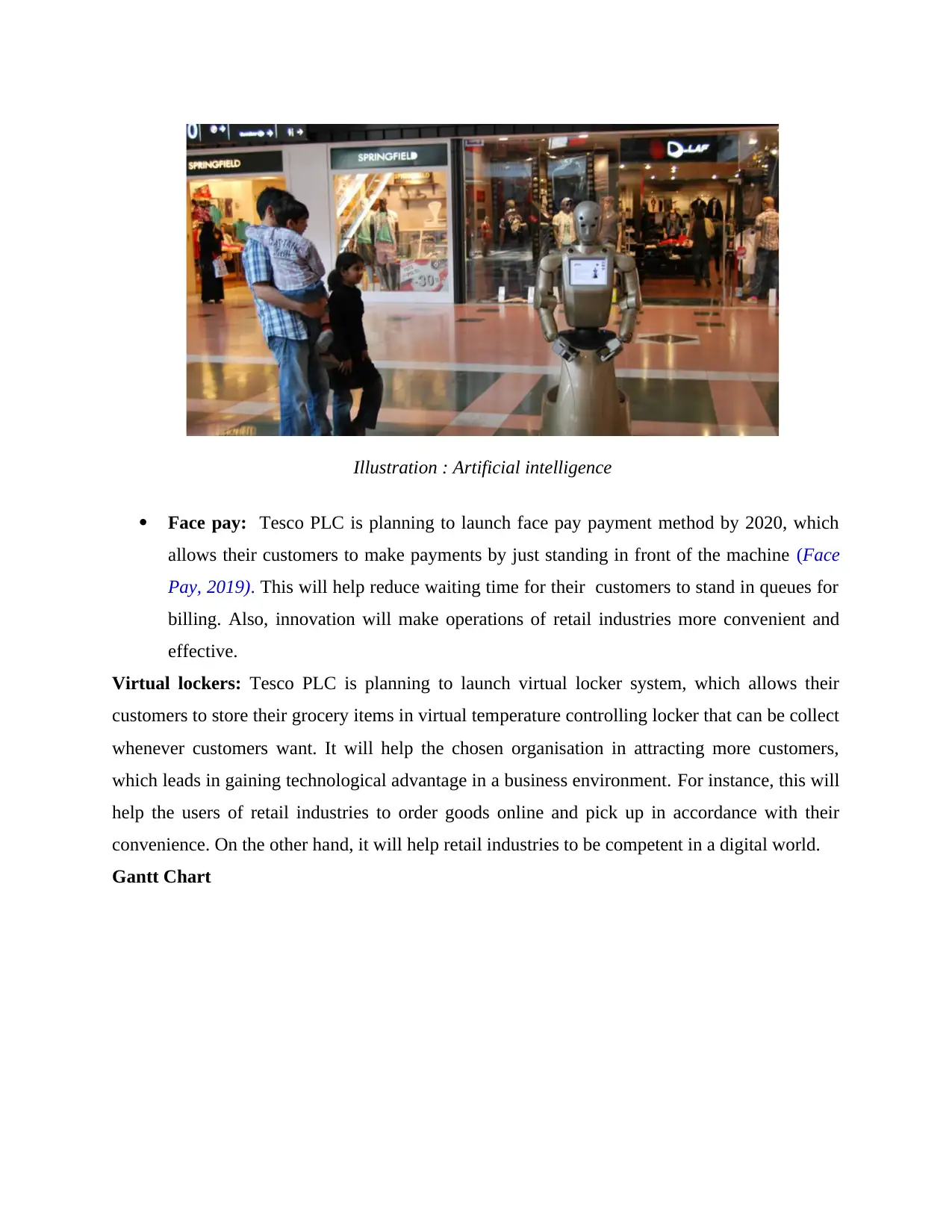
Face pay: Tesco PLC is planning to launch face pay payment method by 2020, which
allows their customers to make payments by just standing in front of the machine (Face
Pay, 2019). This will help reduce waiting time for their customers to stand in queues for
billing. Also, innovation will make operations of retail industries more convenient and
effective.
Virtual lockers: Tesco PLC is planning to launch virtual locker system, which allows their
customers to store their grocery items in virtual temperature controlling locker that can be collect
whenever customers want. It will help the chosen organisation in attracting more customers,
which leads in gaining technological advantage in a business environment. For instance, this will
help the users of retail industries to order goods online and pick up in accordance with their
convenience. On the other hand, it will help retail industries to be competent in a digital world.
Gantt Chart
Illustration : Artificial intelligenceIllustration : Artificial intelligenceIllustration : Artificial intelligenceIllustration : Artificial intelligenceIllustration : Artificial intelligenceIllustration : Artificial intelligenceIllustration : Artificial intelligenceIllustration : Artificial intelligenceIllustration : Artificial intelligenceIllustration : Artificial intelligenceIllustration : Artificial intelligenceIllustration : Artificial intelligenceIllustration : Artificial intelligenceIllustration : Artificial intelligenceIllustration : Artificial intelligenceIllustration : Artificial intelligenceIllustration : Artificial intelligenceIllustration : Artificial intelligenceIllustration : Artificial intelligenceIllustration : Artificial intelligenceIllustration : Artificial intelligenceIllustration : Artificial intelligenceIllustration : Artificial intelligenceIllustration : Artificial intelligenceIllustration : Artificial intelligenceIllustration : Artificial intelligenceIllustration : Artificial intelligenceIllustration : Artificial intelligenceIllustration : Artificial intelligenceIllustration : Artificial intelligenceIllustration : Artificial intelligenceIllustration : Artificial intelligenceIllustration : Artificial intelligenceIllustration : Artificial intelligenceIllustration : Artificial intelligenceIllustration : Artificial intelligenceIllustration : Artificial intelligenceIllustration : Artificial intelligenceIllustration : Artificial intelligenceIllustration : Artificial intelligenceIllustration : Artificial intelligenceIllustration : Artificial intelligenceIllustration : Artificial intelligenceIllustration : Artificial intelligenceIllustration : Artificial intelligenceIllustration : Artificial intelligenceIllustration : Artificial intelligenceIllustration : Artificial intelligenceIllustration : Artificial intelligenceIllustration : Artificial intelligenceIllustration : Artificial intelligenceIllustration : Artificial intelligenceIllustration : Artificial intelligenceIllustration : Artificial intelligenceIllustration : Artificial intelligenceIllustration : Artificial intelligenceIllustration : Artificial intelligenceIllustration : Artificial intelligenceIllustration : Artificial intelligenceIllustration : Artificial intelligenceIllustration : Artificial intelligenceIllustration : Artificial intelligenceIllustration : Artificial intelligenceIllustration : Artificial intelligenceIllustration : Artificial intelligenceIllustration : Artificial intelligenceIllustration : Artificial intelligenceIllustration : Artificial intelligenceIllustration : Artificial intelligenceIllustration : Artificial intelligenceIllustration : Artificial intelligenceIllustration : Artificial intelligenceIllustration : Artificial intelligenceIllustration : Artificial intelligenceIllustration : Artificial intelligenceIllustration : Artificial intelligenceIllustration : Artificial intelligenceIllustration : Artificial intelligenceIllustration : Artificial intelligenceIllustration : Artificial intelligenceIllustration : Artificial intelligenceIllustration : Artificial intelligenceIllustration : Artificial intelligenceIllustration : Artificial intelligenceIllustration : Artificial intelligenceIllustration : Artificial intelligenceIllustration : Artificial intelligenceIllustration : Artificial intelligenceIllustration : Artificial intelligenceIllustration : Artificial intelligenceIllustration : Artificial intelligenceIllustration : Artificial intelligenceIllustration : Artificial intelligenceIllustration : Artificial intelligenceIllustration 1: Artificial intelligenceIllustration : Artificial intelligenceIllustration : Artificial intelligenceIllustration : Artificial intelligenceIllustration : Artificial intelligenceIllustration : Artificial intelligenceIllustration : Artificial intelligenceIllustration : Artificial intelligenceIllustration : Artificial intelligenceIllustration : Artificial intelligenceIllustration : Artificial intelligenceIllustration : Artificial intelligenceIllustration : Artificial intelligenceIllustration : Artificial intelligenceIllustration : Artificial intelligenceIllustration : Artificial intelligenceIllustration : Artificial intelligenceIllustration : Artificial intelligenceIllustration : Artificial intelligenceIllustration : Artificial intelligenceIllustration : Artificial intelligenceIllustration : Artificial intelligenceIllustration : Artificial intelligenceIllustration : Artificial intelligenceIllustration : Artificial intelligenceIllustration : Artificial intelligenceIllustration : Artificial intelligenceIllustration : Artificial intelligenceIllustration : Artificial intelligenceIllustration : Artificial intelligenceIllustration : Artificial intelligenceIllustration : Artificial intelligenceIllustration : Artificial intelligenceIllustration : Artificial intelligence
allows their customers to make payments by just standing in front of the machine (Face
Pay, 2019). This will help reduce waiting time for their customers to stand in queues for
billing. Also, innovation will make operations of retail industries more convenient and
effective.
Virtual lockers: Tesco PLC is planning to launch virtual locker system, which allows their
customers to store their grocery items in virtual temperature controlling locker that can be collect
whenever customers want. It will help the chosen organisation in attracting more customers,
which leads in gaining technological advantage in a business environment. For instance, this will
help the users of retail industries to order goods online and pick up in accordance with their
convenience. On the other hand, it will help retail industries to be competent in a digital world.
Gantt Chart
Illustration : Artificial intelligenceIllustration : Artificial intelligenceIllustration : Artificial intelligenceIllustration : Artificial intelligenceIllustration : Artificial intelligenceIllustration : Artificial intelligenceIllustration : Artificial intelligenceIllustration : Artificial intelligenceIllustration : Artificial intelligenceIllustration : Artificial intelligenceIllustration : Artificial intelligenceIllustration : Artificial intelligenceIllustration : Artificial intelligenceIllustration : Artificial intelligenceIllustration : Artificial intelligenceIllustration : Artificial intelligenceIllustration : Artificial intelligenceIllustration : Artificial intelligenceIllustration : Artificial intelligenceIllustration : Artificial intelligenceIllustration : Artificial intelligenceIllustration : Artificial intelligenceIllustration : Artificial intelligenceIllustration : Artificial intelligenceIllustration : Artificial intelligenceIllustration : Artificial intelligenceIllustration : Artificial intelligenceIllustration : Artificial intelligenceIllustration : Artificial intelligenceIllustration : Artificial intelligenceIllustration : Artificial intelligenceIllustration : Artificial intelligenceIllustration : Artificial intelligenceIllustration : Artificial intelligenceIllustration : Artificial intelligenceIllustration : Artificial intelligenceIllustration : Artificial intelligenceIllustration : Artificial intelligenceIllustration : Artificial intelligenceIllustration : Artificial intelligenceIllustration : Artificial intelligenceIllustration : Artificial intelligenceIllustration : Artificial intelligenceIllustration : Artificial intelligenceIllustration : Artificial intelligenceIllustration : Artificial intelligenceIllustration : Artificial intelligenceIllustration : Artificial intelligenceIllustration : Artificial intelligenceIllustration : Artificial intelligenceIllustration : Artificial intelligenceIllustration : Artificial intelligenceIllustration : Artificial intelligenceIllustration : Artificial intelligenceIllustration : Artificial intelligenceIllustration : Artificial intelligenceIllustration : Artificial intelligenceIllustration : Artificial intelligenceIllustration : Artificial intelligenceIllustration : Artificial intelligenceIllustration : Artificial intelligenceIllustration : Artificial intelligenceIllustration : Artificial intelligenceIllustration : Artificial intelligenceIllustration : Artificial intelligenceIllustration : Artificial intelligenceIllustration : Artificial intelligenceIllustration : Artificial intelligenceIllustration : Artificial intelligenceIllustration : Artificial intelligenceIllustration : Artificial intelligenceIllustration : Artificial intelligenceIllustration : Artificial intelligenceIllustration : Artificial intelligenceIllustration : Artificial intelligenceIllustration : Artificial intelligenceIllustration : Artificial intelligenceIllustration : Artificial intelligenceIllustration : Artificial intelligenceIllustration : Artificial intelligenceIllustration : Artificial intelligenceIllustration : Artificial intelligenceIllustration : Artificial intelligenceIllustration : Artificial intelligenceIllustration : Artificial intelligenceIllustration : Artificial intelligenceIllustration : Artificial intelligenceIllustration : Artificial intelligenceIllustration : Artificial intelligenceIllustration : Artificial intelligenceIllustration : Artificial intelligenceIllustration : Artificial intelligenceIllustration : Artificial intelligenceIllustration : Artificial intelligenceIllustration 1: Artificial intelligenceIllustration : Artificial intelligenceIllustration : Artificial intelligenceIllustration : Artificial intelligenceIllustration : Artificial intelligenceIllustration : Artificial intelligenceIllustration : Artificial intelligenceIllustration : Artificial intelligenceIllustration : Artificial intelligenceIllustration : Artificial intelligenceIllustration : Artificial intelligenceIllustration : Artificial intelligenceIllustration : Artificial intelligenceIllustration : Artificial intelligenceIllustration : Artificial intelligenceIllustration : Artificial intelligenceIllustration : Artificial intelligenceIllustration : Artificial intelligenceIllustration : Artificial intelligenceIllustration : Artificial intelligenceIllustration : Artificial intelligenceIllustration : Artificial intelligenceIllustration : Artificial intelligenceIllustration : Artificial intelligenceIllustration : Artificial intelligenceIllustration : Artificial intelligenceIllustration : Artificial intelligenceIllustration : Artificial intelligenceIllustration : Artificial intelligenceIllustration : Artificial intelligenceIllustration : Artificial intelligenceIllustration : Artificial intelligenceIllustration : Artificial intelligenceIllustration : Artificial intelligence
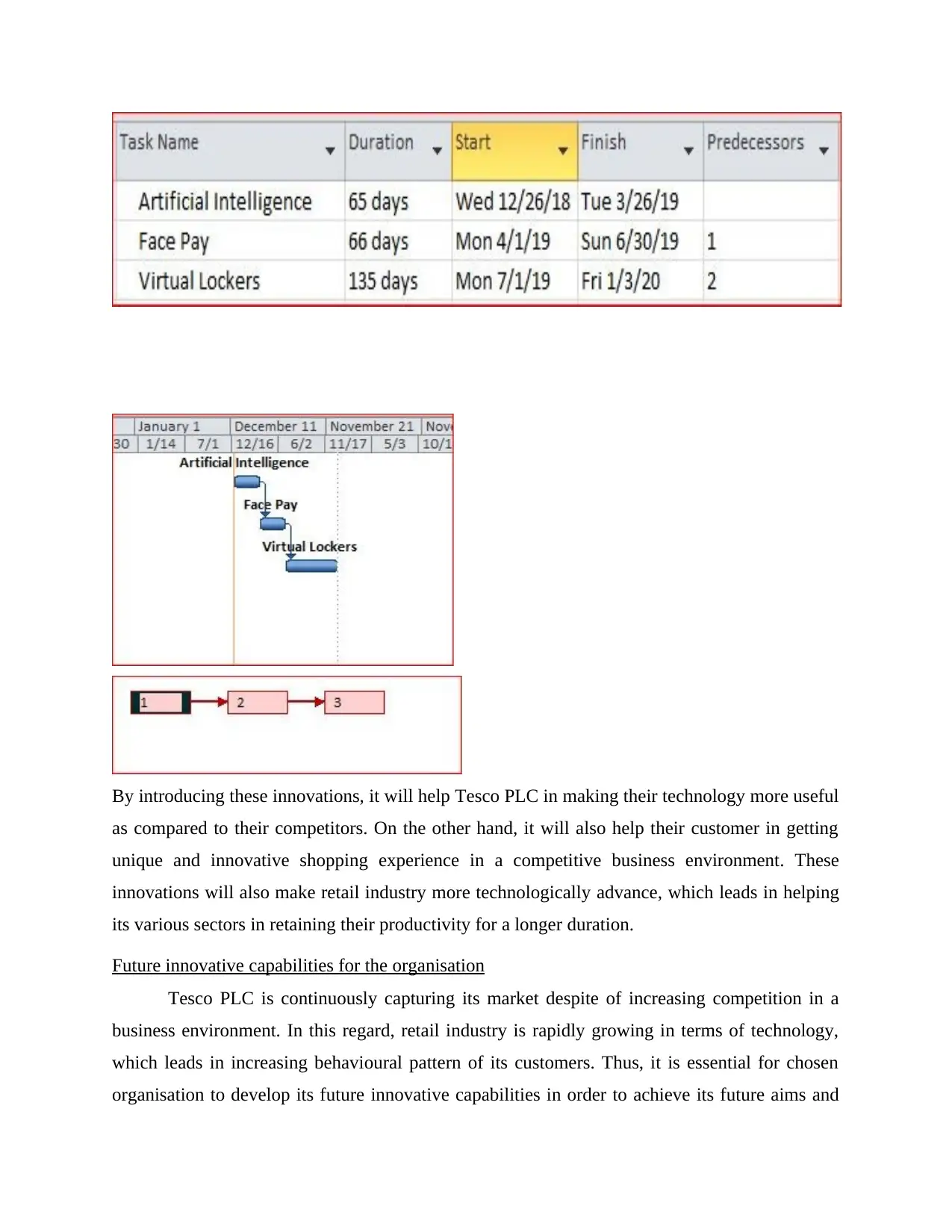
By introducing these innovations, it will help Tesco PLC in making their technology more useful
as compared to their competitors. On the other hand, it will also help their customer in getting
unique and innovative shopping experience in a competitive business environment. These
innovations will also make retail industry more technologically advance, which leads in helping
its various sectors in retaining their productivity for a longer duration.
Future innovative capabilities for the organisation
Tesco PLC is continuously capturing its market despite of increasing competition in a
business environment. In this regard, retail industry is rapidly growing in terms of technology,
which leads in increasing behavioural pattern of its customers. Thus, it is essential for chosen
organisation to develop its future innovative capabilities in order to achieve its future aims and
as compared to their competitors. On the other hand, it will also help their customer in getting
unique and innovative shopping experience in a competitive business environment. These
innovations will also make retail industry more technologically advance, which leads in helping
its various sectors in retaining their productivity for a longer duration.
Future innovative capabilities for the organisation
Tesco PLC is continuously capturing its market despite of increasing competition in a
business environment. In this regard, retail industry is rapidly growing in terms of technology,
which leads in increasing behavioural pattern of its customers. Thus, it is essential for chosen
organisation to develop its future innovative capabilities in order to achieve its future aims and
⊘ This is a preview!⊘
Do you want full access?
Subscribe today to unlock all pages.

Trusted by 1+ million students worldwide
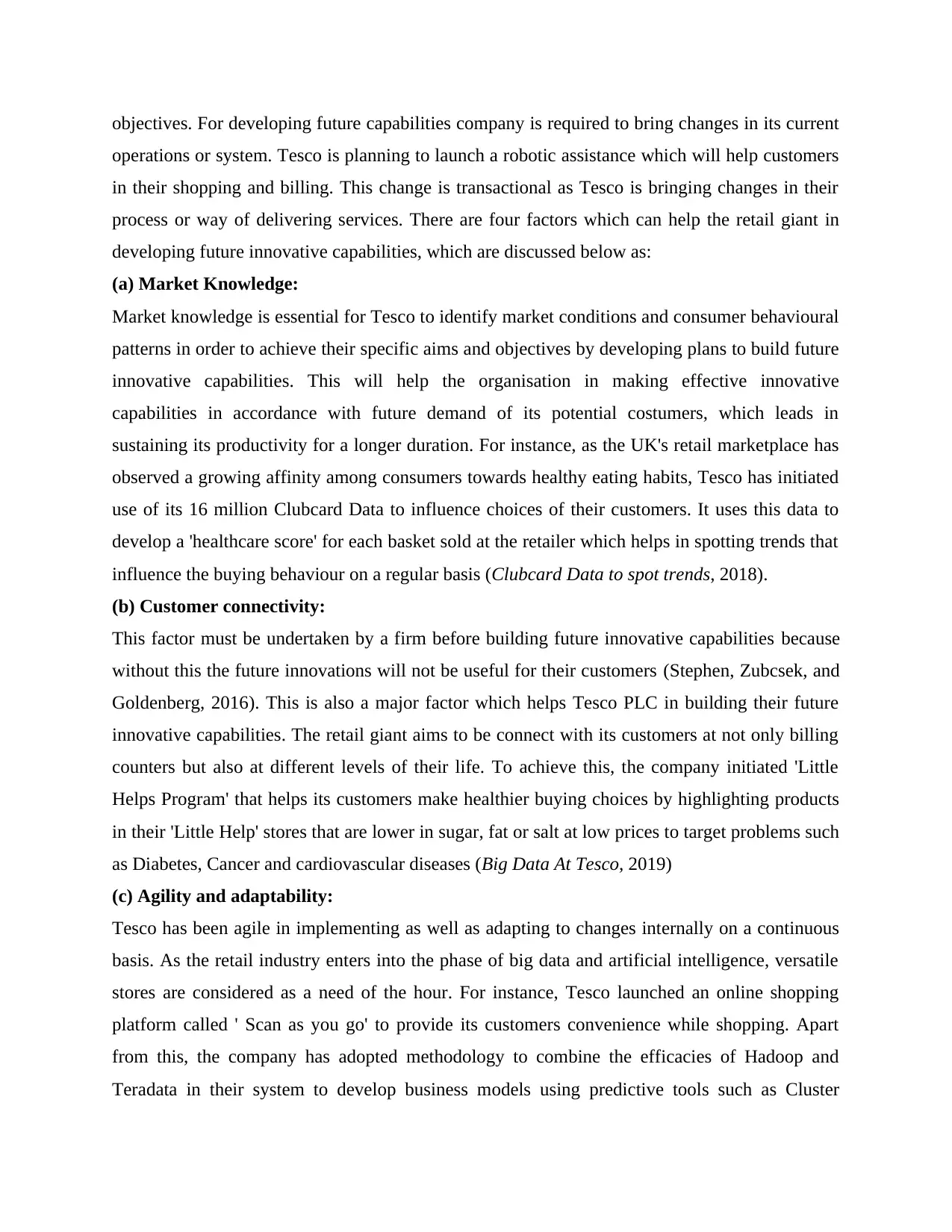
objectives. For developing future capabilities company is required to bring changes in its current
operations or system. Tesco is planning to launch a robotic assistance which will help customers
in their shopping and billing. This change is transactional as Tesco is bringing changes in their
process or way of delivering services. There are four factors which can help the retail giant in
developing future innovative capabilities, which are discussed below as:
(a) Market Knowledge:
Market knowledge is essential for Tesco to identify market conditions and consumer behavioural
patterns in order to achieve their specific aims and objectives by developing plans to build future
innovative capabilities. This will help the organisation in making effective innovative
capabilities in accordance with future demand of its potential costumers, which leads in
sustaining its productivity for a longer duration. For instance, as the UK's retail marketplace has
observed a growing affinity among consumers towards healthy eating habits, Tesco has initiated
use of its 16 million Clubcard Data to influence choices of their customers. It uses this data to
develop a 'healthcare score' for each basket sold at the retailer which helps in spotting trends that
influence the buying behaviour on a regular basis (Clubcard Data to spot trends, 2018).
(b) Customer connectivity:
This factor must be undertaken by a firm before building future innovative capabilities because
without this the future innovations will not be useful for their customers (Stephen, Zubcsek, and
Goldenberg, 2016). This is also a major factor which helps Tesco PLC in building their future
innovative capabilities. The retail giant aims to be connect with its customers at not only billing
counters but also at different levels of their life. To achieve this, the company initiated 'Little
Helps Program' that helps its customers make healthier buying choices by highlighting products
in their 'Little Help' stores that are lower in sugar, fat or salt at low prices to target problems such
as Diabetes, Cancer and cardiovascular diseases (Big Data At Tesco, 2019)
(c) Agility and adaptability:
Tesco has been agile in implementing as well as adapting to changes internally on a continuous
basis. As the retail industry enters into the phase of big data and artificial intelligence, versatile
stores are considered as a need of the hour. For instance, Tesco launched an online shopping
platform called ' Scan as you go' to provide its customers convenience while shopping. Apart
from this, the company has adopted methodology to combine the efficacies of Hadoop and
Teradata in their system to develop business models using predictive tools such as Cluster
operations or system. Tesco is planning to launch a robotic assistance which will help customers
in their shopping and billing. This change is transactional as Tesco is bringing changes in their
process or way of delivering services. There are four factors which can help the retail giant in
developing future innovative capabilities, which are discussed below as:
(a) Market Knowledge:
Market knowledge is essential for Tesco to identify market conditions and consumer behavioural
patterns in order to achieve their specific aims and objectives by developing plans to build future
innovative capabilities. This will help the organisation in making effective innovative
capabilities in accordance with future demand of its potential costumers, which leads in
sustaining its productivity for a longer duration. For instance, as the UK's retail marketplace has
observed a growing affinity among consumers towards healthy eating habits, Tesco has initiated
use of its 16 million Clubcard Data to influence choices of their customers. It uses this data to
develop a 'healthcare score' for each basket sold at the retailer which helps in spotting trends that
influence the buying behaviour on a regular basis (Clubcard Data to spot trends, 2018).
(b) Customer connectivity:
This factor must be undertaken by a firm before building future innovative capabilities because
without this the future innovations will not be useful for their customers (Stephen, Zubcsek, and
Goldenberg, 2016). This is also a major factor which helps Tesco PLC in building their future
innovative capabilities. The retail giant aims to be connect with its customers at not only billing
counters but also at different levels of their life. To achieve this, the company initiated 'Little
Helps Program' that helps its customers make healthier buying choices by highlighting products
in their 'Little Help' stores that are lower in sugar, fat or salt at low prices to target problems such
as Diabetes, Cancer and cardiovascular diseases (Big Data At Tesco, 2019)
(c) Agility and adaptability:
Tesco has been agile in implementing as well as adapting to changes internally on a continuous
basis. As the retail industry enters into the phase of big data and artificial intelligence, versatile
stores are considered as a need of the hour. For instance, Tesco launched an online shopping
platform called ' Scan as you go' to provide its customers convenience while shopping. Apart
from this, the company has adopted methodology to combine the efficacies of Hadoop and
Teradata in their system to develop business models using predictive tools such as Cluster
Paraphrase This Document
Need a fresh take? Get an instant paraphrase of this document with our AI Paraphraser
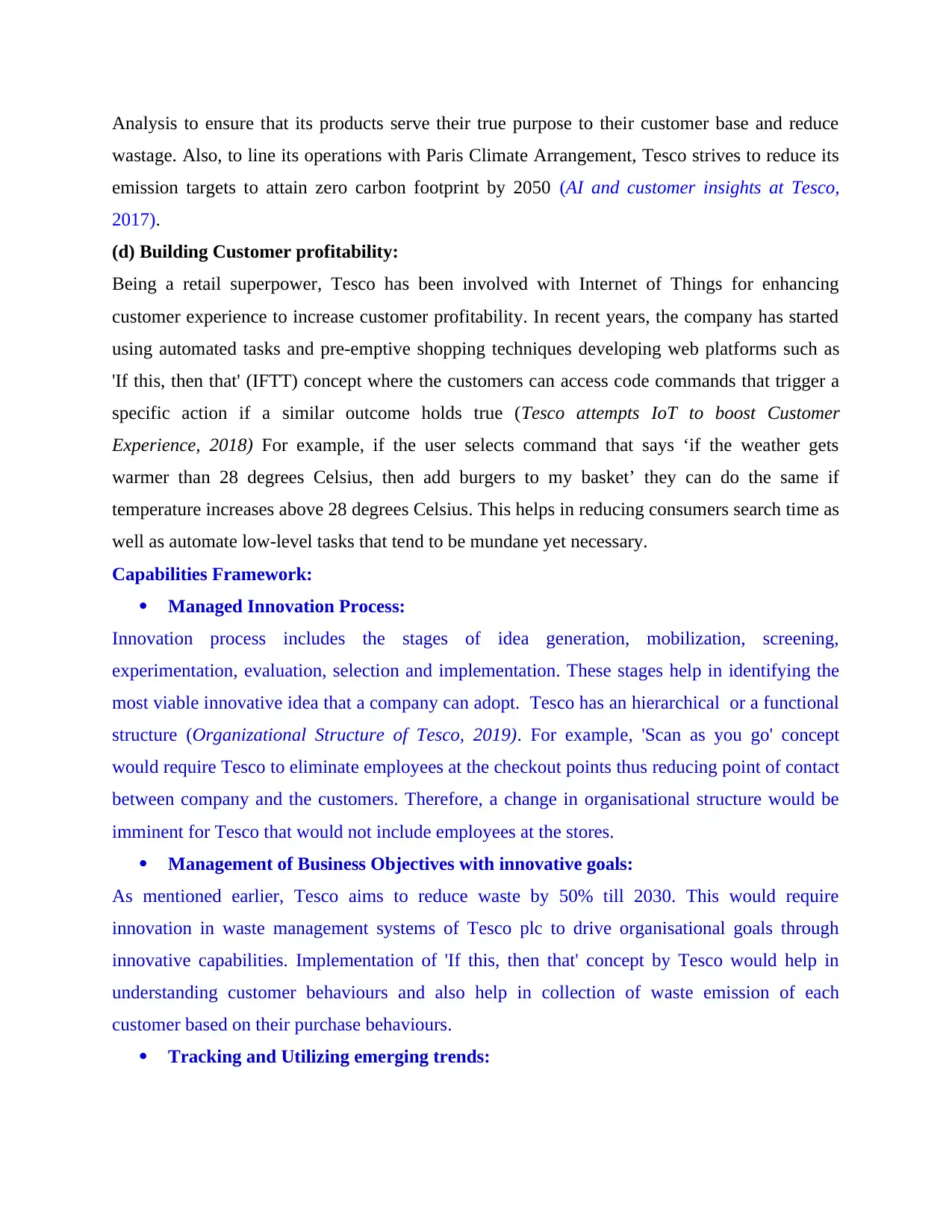
Analysis to ensure that its products serve their true purpose to their customer base and reduce
wastage. Also, to line its operations with Paris Climate Arrangement, Tesco strives to reduce its
emission targets to attain zero carbon footprint by 2050 (AI and customer insights at Tesco,
2017).
(d) Building Customer profitability:
Being a retail superpower, Tesco has been involved with Internet of Things for enhancing
customer experience to increase customer profitability. In recent years, the company has started
using automated tasks and pre-emptive shopping techniques developing web platforms such as
'If this, then that' (IFTT) concept where the customers can access code commands that trigger a
specific action if a similar outcome holds true (Tesco attempts IoT to boost Customer
Experience, 2018) For example, if the user selects command that says ‘if the weather gets
warmer than 28 degrees Celsius, then add burgers to my basket’ they can do the same if
temperature increases above 28 degrees Celsius. This helps in reducing consumers search time as
well as automate low-level tasks that tend to be mundane yet necessary.
Capabilities Framework:
Managed Innovation Process:
Innovation process includes the stages of idea generation, mobilization, screening,
experimentation, evaluation, selection and implementation. These stages help in identifying the
most viable innovative idea that a company can adopt. Tesco has an hierarchical or a functional
structure (Organizational Structure of Tesco, 2019). For example, 'Scan as you go' concept
would require Tesco to eliminate employees at the checkout points thus reducing point of contact
between company and the customers. Therefore, a change in organisational structure would be
imminent for Tesco that would not include employees at the stores.
Management of Business Objectives with innovative goals:
As mentioned earlier, Tesco aims to reduce waste by 50% till 2030. This would require
innovation in waste management systems of Tesco plc to drive organisational goals through
innovative capabilities. Implementation of 'If this, then that' concept by Tesco would help in
understanding customer behaviours and also help in collection of waste emission of each
customer based on their purchase behaviours.
Tracking and Utilizing emerging trends:
wastage. Also, to line its operations with Paris Climate Arrangement, Tesco strives to reduce its
emission targets to attain zero carbon footprint by 2050 (AI and customer insights at Tesco,
2017).
(d) Building Customer profitability:
Being a retail superpower, Tesco has been involved with Internet of Things for enhancing
customer experience to increase customer profitability. In recent years, the company has started
using automated tasks and pre-emptive shopping techniques developing web platforms such as
'If this, then that' (IFTT) concept where the customers can access code commands that trigger a
specific action if a similar outcome holds true (Tesco attempts IoT to boost Customer
Experience, 2018) For example, if the user selects command that says ‘if the weather gets
warmer than 28 degrees Celsius, then add burgers to my basket’ they can do the same if
temperature increases above 28 degrees Celsius. This helps in reducing consumers search time as
well as automate low-level tasks that tend to be mundane yet necessary.
Capabilities Framework:
Managed Innovation Process:
Innovation process includes the stages of idea generation, mobilization, screening,
experimentation, evaluation, selection and implementation. These stages help in identifying the
most viable innovative idea that a company can adopt. Tesco has an hierarchical or a functional
structure (Organizational Structure of Tesco, 2019). For example, 'Scan as you go' concept
would require Tesco to eliminate employees at the checkout points thus reducing point of contact
between company and the customers. Therefore, a change in organisational structure would be
imminent for Tesco that would not include employees at the stores.
Management of Business Objectives with innovative goals:
As mentioned earlier, Tesco aims to reduce waste by 50% till 2030. This would require
innovation in waste management systems of Tesco plc to drive organisational goals through
innovative capabilities. Implementation of 'If this, then that' concept by Tesco would help in
understanding customer behaviours and also help in collection of waste emission of each
customer based on their purchase behaviours.
Tracking and Utilizing emerging trends:
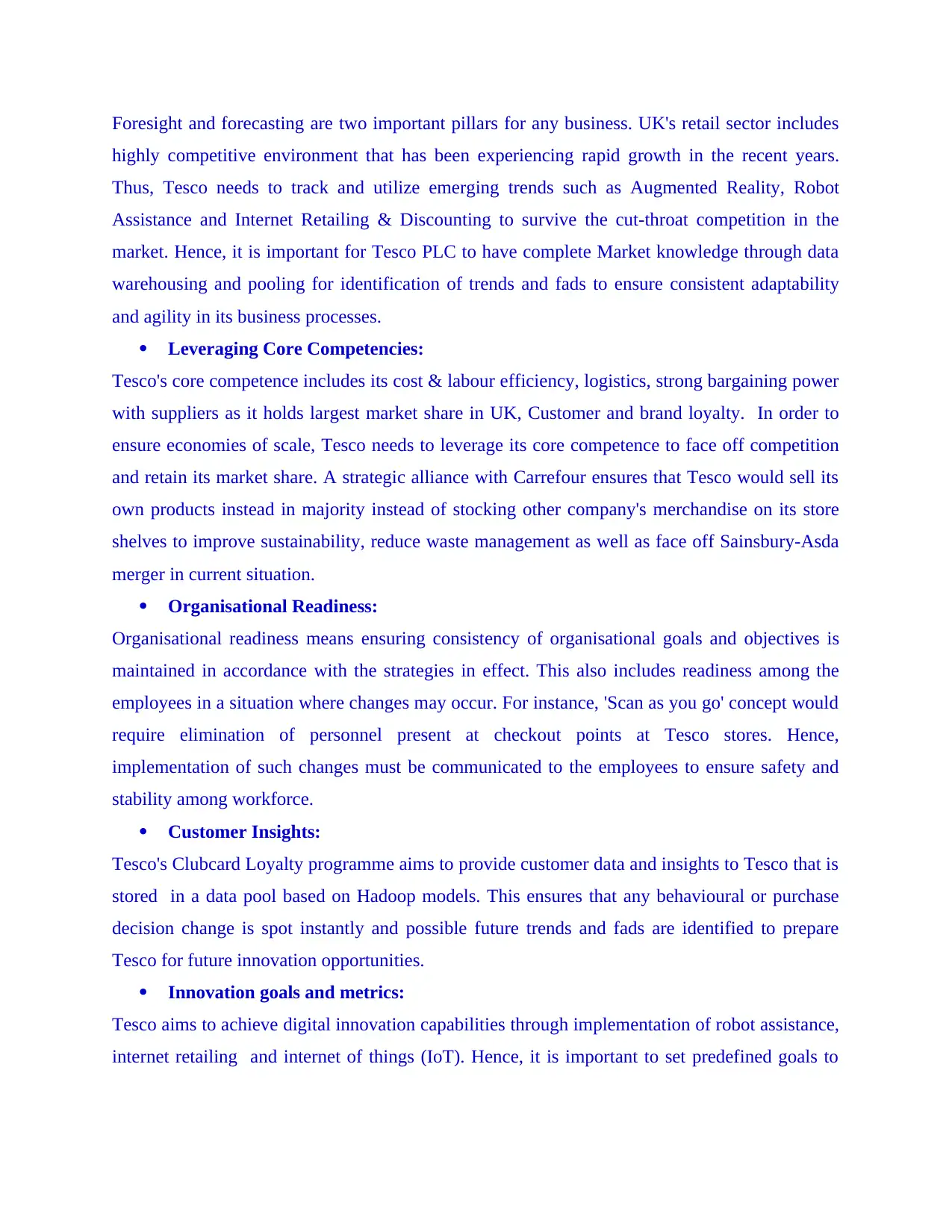
Foresight and forecasting are two important pillars for any business. UK's retail sector includes
highly competitive environment that has been experiencing rapid growth in the recent years.
Thus, Tesco needs to track and utilize emerging trends such as Augmented Reality, Robot
Assistance and Internet Retailing & Discounting to survive the cut-throat competition in the
market. Hence, it is important for Tesco PLC to have complete Market knowledge through data
warehousing and pooling for identification of trends and fads to ensure consistent adaptability
and agility in its business processes.
Leveraging Core Competencies:
Tesco's core competence includes its cost & labour efficiency, logistics, strong bargaining power
with suppliers as it holds largest market share in UK, Customer and brand loyalty. In order to
ensure economies of scale, Tesco needs to leverage its core competence to face off competition
and retain its market share. A strategic alliance with Carrefour ensures that Tesco would sell its
own products instead in majority instead of stocking other company's merchandise on its store
shelves to improve sustainability, reduce waste management as well as face off Sainsbury-Asda
merger in current situation.
Organisational Readiness:
Organisational readiness means ensuring consistency of organisational goals and objectives is
maintained in accordance with the strategies in effect. This also includes readiness among the
employees in a situation where changes may occur. For instance, 'Scan as you go' concept would
require elimination of personnel present at checkout points at Tesco stores. Hence,
implementation of such changes must be communicated to the employees to ensure safety and
stability among workforce.
Customer Insights:
Tesco's Clubcard Loyalty programme aims to provide customer data and insights to Tesco that is
stored in a data pool based on Hadoop models. This ensures that any behavioural or purchase
decision change is spot instantly and possible future trends and fads are identified to prepare
Tesco for future innovation opportunities.
Innovation goals and metrics:
Tesco aims to achieve digital innovation capabilities through implementation of robot assistance,
internet retailing and internet of things (IoT). Hence, it is important to set predefined goals to
highly competitive environment that has been experiencing rapid growth in the recent years.
Thus, Tesco needs to track and utilize emerging trends such as Augmented Reality, Robot
Assistance and Internet Retailing & Discounting to survive the cut-throat competition in the
market. Hence, it is important for Tesco PLC to have complete Market knowledge through data
warehousing and pooling for identification of trends and fads to ensure consistent adaptability
and agility in its business processes.
Leveraging Core Competencies:
Tesco's core competence includes its cost & labour efficiency, logistics, strong bargaining power
with suppliers as it holds largest market share in UK, Customer and brand loyalty. In order to
ensure economies of scale, Tesco needs to leverage its core competence to face off competition
and retain its market share. A strategic alliance with Carrefour ensures that Tesco would sell its
own products instead in majority instead of stocking other company's merchandise on its store
shelves to improve sustainability, reduce waste management as well as face off Sainsbury-Asda
merger in current situation.
Organisational Readiness:
Organisational readiness means ensuring consistency of organisational goals and objectives is
maintained in accordance with the strategies in effect. This also includes readiness among the
employees in a situation where changes may occur. For instance, 'Scan as you go' concept would
require elimination of personnel present at checkout points at Tesco stores. Hence,
implementation of such changes must be communicated to the employees to ensure safety and
stability among workforce.
Customer Insights:
Tesco's Clubcard Loyalty programme aims to provide customer data and insights to Tesco that is
stored in a data pool based on Hadoop models. This ensures that any behavioural or purchase
decision change is spot instantly and possible future trends and fads are identified to prepare
Tesco for future innovation opportunities.
Innovation goals and metrics:
Tesco aims to achieve digital innovation capabilities through implementation of robot assistance,
internet retailing and internet of things (IoT). Hence, it is important to set predefined goals to
⊘ This is a preview!⊘
Do you want full access?
Subscribe today to unlock all pages.

Trusted by 1+ million students worldwide
1 out of 18
Related Documents
Your All-in-One AI-Powered Toolkit for Academic Success.
+13062052269
info@desklib.com
Available 24*7 on WhatsApp / Email
![[object Object]](/_next/static/media/star-bottom.7253800d.svg)
Unlock your academic potential
Copyright © 2020–2025 A2Z Services. All Rights Reserved. Developed and managed by ZUCOL.





